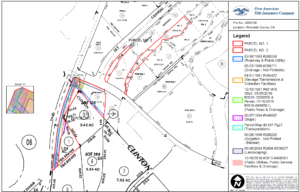ARGUS BITS
SAMPLE BITS
 What Gets Approved?
What Gets Approved?
In the entitlement process, a developer is essentially asking the local jurisdiction to approve a project. For housing, a common document that gets submitted for review and approval is a tentative tract map (TTM).
Read MoreRead Less
This TTM is usually the preliminary engineering that illustrates the grading design, street circulation, street widths, lot layout, lot sizes/dimensions, utility locations, and other project features. The approval of a TTM provides for the number of lots, overall project design, and project conditions.
In other cases, the project approval may be something less specific but still very valuable in the entitlement process. With larger projects and master planned communities, a specific plan might be submitted for review and approval, which can provide the overall community design and zoning standards for a multi-parcel community. Multiple TTM’s may be submitted later for approval, but the specific plan can be a very important approval that provides the foundation for the more specific project approvals.
Other higher-level approvals may be for a general plan amendment (GPA) or zone change. If the city’s general plan land use designation and zoning call for commercial uses, getting the approval for the GPA and zone change to residential could provide significant additional property value. In many cases the GPA and zone change approval may be included with the TTM approval, but at times there are good reasons to just submit the GPA and zone change request prior to submitting the TTM.
In essence, entitlements and the project approvals should increase the value of a property. The entitlement approvals do not provide for construction permits, which are generally the next steps and are administered by the city staff departments. But getting to these project approvals – referred also as “discretionary approvals” – can be a one-step or multi-step process.
What Are Plotted Easements?
One purpose of a preliminary title report and an eventual title policy is to document the recorded encumbrances on a particular property. The title company will provide title insurance, essentially ensuring that a buyer will have clear title to a property.
Read MoreRead Less
However, in most cases the title company will list “exceptions” to their title policy, which are generally recorded title documents that in some manner impact the use of the property. One of the main categories of these exceptions are easements – which is the right of another party to use a portion of the property.
Some very common easements are those issued to utility companies, such as a water agency or electrical company. Some easements may be granted to a private party, perhaps for the right to travel across the property or maybe providing access for maintenance of a property line wall. The easement document itself can have 1 – 3 pages of legal narrative and is almost always accompanied by legal description, which describes where the easement is located. The easement location could be a 25-foot wide swath across the property, a 5-foot strip adjacent to the property line, or possibly a rectangular or trapezoidal shape. It all depends on what the easement was needed for and granted by a previous property owner.
Especially as it relates to developing a property, it is imperative to understand the locations of these easements. A title company will provide a “plotted easement” graphic, which tends to be a map of the property with the easements plotted in color codes that tie back to the exceptions on the title report. These plotted easements now indicate the location of the easements and how they might encumber your future use of the property.
When ordering a preliminary title report, it is just a matter of asking that plotted easements are provided with the report. If you do not receive the graphic or there are no easements plotted, it is possible that no recorded easements encumber the property. At that point, you would want to review the exceptions within the title report and confirm no easements are listed.
Keep in mind that the title company will probably state that they offer no assurances as to the accuracy of the plotted easements. When you are doing your due diligence, it is not a bad idea to get a civil engineer or surveyor to review the plots to make sure a mistake was not made.
Why A Specific Plan?
In a previous post, we mentioned that a project approval may be for a “specific plan”, which does not provide for street and lot layouts like a tentative tract map, but yet it can be a very valuable approval document for downstream approvals. The specific plan is essentially creating project-specific zoning codes for multiple parcels, which can be beneficial to both the developer and the local jurisdiction.
Read MoreRead Less
As an example, let’s say that you have a 200-acre parcel that has a general plan use designation and zoning for 5 homes per acre – or 1,000 homes in total. However, for that large of a project, both the developer and city would probably prefer to see that a variety of housing types get built. And, a project of this size will probably want to include some areas for parks, schools, and possible commercial uses. A specific plan can create the base zoning and land uses for the entire 200 acres.
The specific plan is usually prepared by a land planner with experience in designing master planned communities. The major arterial streets would probably be illustrated and maybe 20 to 30 parcels that have zoning standards. Some parcels could be designated for lower density homes and others for higher density projects, such as apartments. Parcels for parks, open space, shopping centers, schools, and other uses would be in the specific plan. And each of these parcels would have zoning standards that describe what and how the development can get built.
One of the key reasons for specific plans is to allow for the diversity of community uses and home types. But as well, a large master planned community may take years to complete. The market changes and therefore the product needs to be revised as well. If you have a parcel that calls out for 75 – 100 single family lots, a home builder might prefer to build on lot sizes of 50 x 100 based on the market conditions. If the entire 200 acres had a tentative tract map approved for 1,000 lots of 70 x 120, a market opportunity of smaller lots can be missed. As well, a variety of lot sizes and products ensures that multiple builders are not competing against each other for a limited segment of the market – again, missing a market opportunity.



